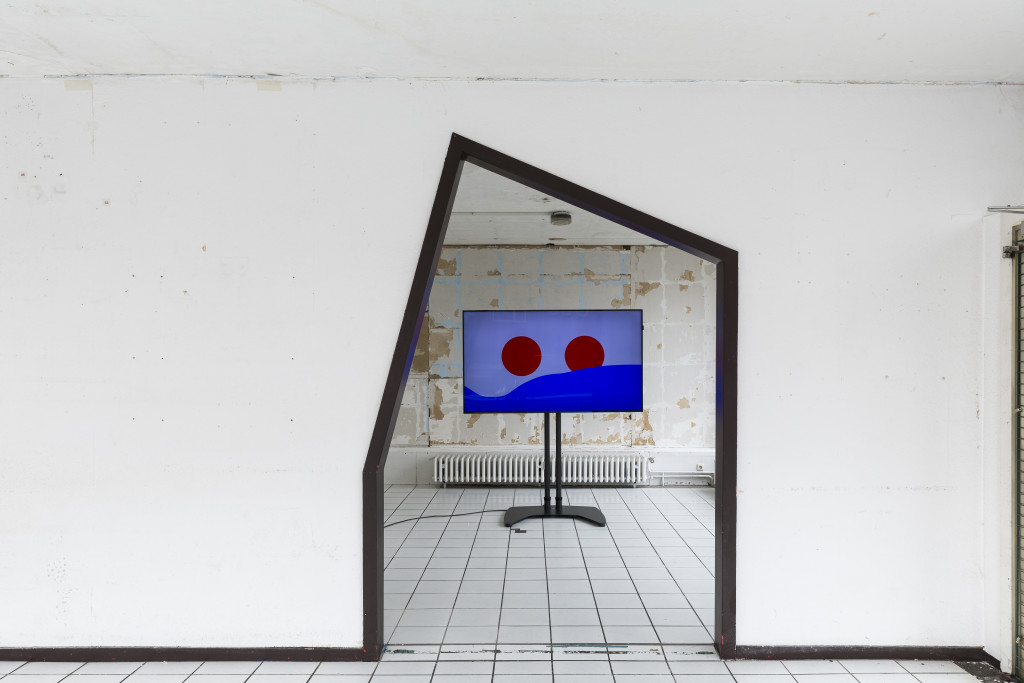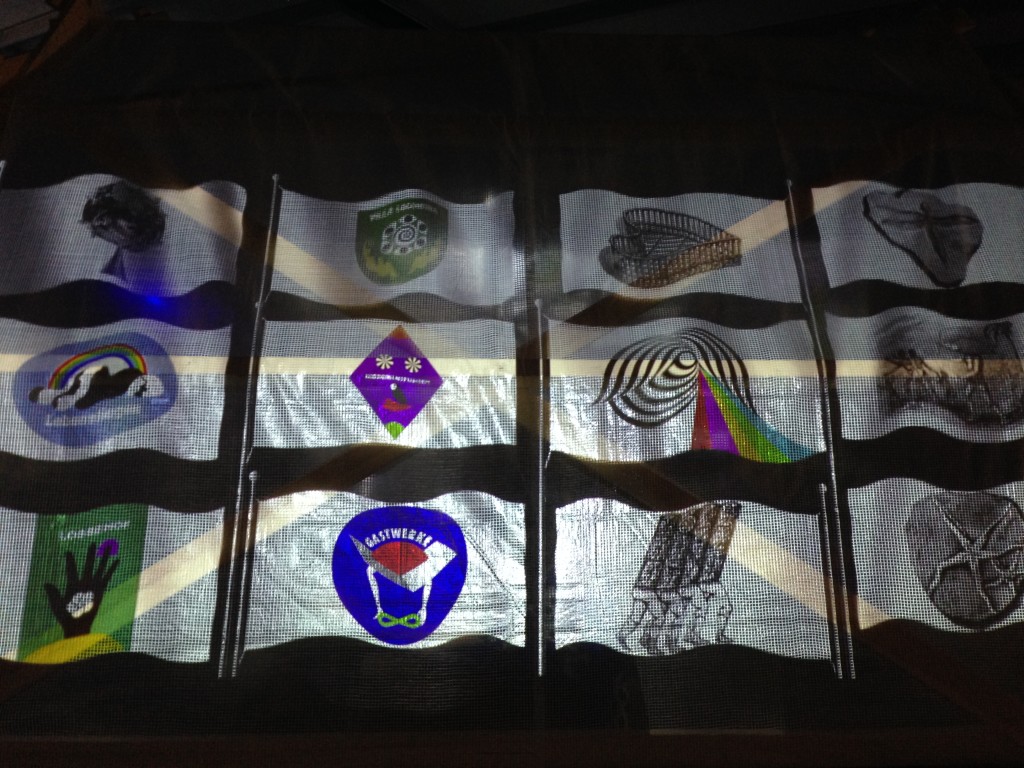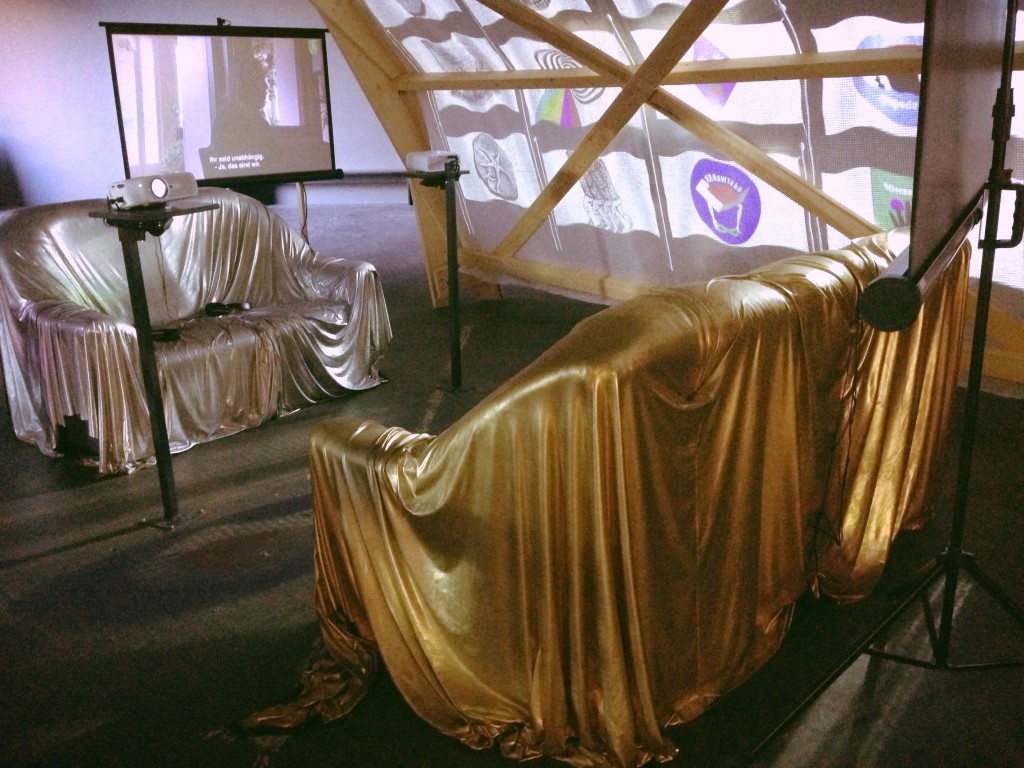Angelo Plessas: Politics of Togetherness // Profile of the Artist
by Alfredo Cramerotti

Kassel, documenta 14, Copyright Fred Dott.
The work of Athens-based artist Angelo Plessas exists in and around the Internet, or in a form he calls “Internet psychogeography.” He registers domain names such as SymmetryOfChaos.com, PlagueOfFantasy.com or MeLookingAtYou.com, placing his characters (either his friends, or versions of himself) in specific situations. Functioning almost sketches for online personas, these websites—and their single domain-name titles—make them unique Internet objects. Plessas Google-Street walks around the world, chooses locations where people meet offline, and organizes events under the guise of the Eternal Internet Brother/Sisterhood once a year, typically crowdsourcing the resources. After each Brother/Sisterhood gathering, he stages elaborate installations with the documentation of these yearly events; works that he considers ‘promotional stands’ for future gatherings—a sort of agitprop environment. The installations feature videos documenting the past proceedings, along with YouTube statements announcing the next venture—referencing social experiments from the earliest days of technology, alternative manifestos on how to be an artist, and made-up recipes for ‘emotional interfaces’ and ‘new social horizons.’ In the latest Brotherhood/Sisterhood gathering for documenta 14, positioned between Kassel and Athens, artists, writers, and thinkers are indeed the medium of Plessas’ work. Gathering and documenting the way these individuals either produce, play, or deal with Internet freedom (or alternately the lack thereof), the online personality of the work evolves through social media—Plessas acts both as facilitator and coach, chaperone and activator. As an online profile states: “Angelo Plessas’ work is a portrait of your online and offline self, Together.”
Alfredo Cramerotti: Let’s start with the main ideas behind your work—I realize this is a big question, and of course I have my own reading of your work, but it may not be the same with what you think are the main guiding principles of what you do. I am interested in knowing how you yourself ‘read’ your work. Can you step outside Angelo for a moment and let me know what you see?
Angelo Plessas: Okay, I will fade out from Angelo and I see that he builds his ideas in and around the Internet. His work explores different sides of this world. I can clearly see he is interested in the multiple interactions between a strange materialism without matter to the shifts of territorialization of the self to ideas of collective and individual experience using a techno-spiritual visual language. I see that his work refers to how our bodies and minds are becoming omnipresent or trackless, how much our attention is fading away and the ongoing illusion of what is happening in the “now.” He also deals with the value of cultural products and how this is being defined within this context of ownership. His work unfolds the present in a way that allows viewers to become participants of his pieces, exploring the physical, spiritual, and intellectual, but also the relations between one another—whether this happens on an interactive website, a museum environment, or a gathering in the jungle.
AC: Did you get any particular source of inspiration for the visual styles of your recent series of works—e.g. Experimental Education Protocol, Delphi or Eternal Internet Brotherhood/Sisterhood 6 (both 2017), the video and projection formats, the storytelling and DIY ambience, or the viewing structures (wooden constructs and sofas), etc.—or did they arrive in relation to the nature of the ‘materials’ (read: people) you have used, and locations you were in?

Copyright Fred Dott.
AP: The Experimental Education Protocol, Delphi happened for the first time as an installation beyond the confines of the [Eternal Internet Brotherhood/Sisterhood] residency program, and for this, I wanted to create something that would convey the environment of a self-made school. So, I thought to make this structure with double-sided raw pieces of wood, which would put the viewer into the world of Maria Zamanou Mickelson—this year’s case study—making a circle of navigating the installation. From the bright-lit outer side, you encounter an introduction to this woman’s life going towards the backside of the installation; it would reveal a more emotional and esoteric side of her temperament, presented alongside the events that resulted from her as an inspirational figure within the residency structure. In this vein, I also contextualize the accompanying folded wooden structures as file-browser windows, where the results of a keyword search are placed almost sloppily like file icons on a screen surface.
AC: Can you dive a bit into the technical aspects of the works? Such as the gathering of raw material, the software or hardware used (in the wide sense; they could be thoughts and bodies), as well as the selection and ‘editing’ process (what you take in and what is left out)? What are some of the particular challenges you and your team face in realizing the works?

AP: It is quite exciting how much material is being generated and archived by these two projects, and in each edition. The challenge is to control and minimize what will go public, what will stay secret, or what will be dug out for later use. This is quite the challenge for me, having the role of the archivist for these activities as well. In this sense, I usually focus on the people and the spirit they bring to the creative process of the project. The content I am filtering for these installations is the energy and dynamism of each one of us in response to this unconventional space. So I also act a bit like a psychoanalyst. For example, the collective performance we did in the Dead Sea for the third edition, or the Robot Poetry Singing in Kassel now. During every Eternal Internet Brother/Sisterhood and Experimental Education Protocol program, I am the cameraman, shooting various moments, archiving in very extreme conditions—such as dangerous conflicted areas, severe heat and cold, wild nature, or no electricity; it is a bit like shooting for National Geographic. In the videos, there is very little editing or filters for post-production, and the footage is shot entirely from my iPhone. I like maintaining a “primitive” language of the internet, something like a technological arte povera.
AC: I saw a couple of recent installations of your work for documenta 14 in both Athens and Kassel—they were basically made of a series of ‘spaces’ that the viewer was moving from and to. Visitors would walk underneath, above, and into them—or beside, between, and within them—but could not really see them from an ‘external’ point of view. You chose instead to have an ‘immersive’ type of installation. What is the underlying approach to this?

AP: For the Eternal Internet Brotherhood/Sisterhood 6 installation, I wanted to do something in a setting where the viewers would also be possible participants in a lively and vivid situation. They are surrounded by a material that was produced during and for the residency, which happened in the Lebensbogen commune outside of Kassel a month before documenta 14 opened. As in another iteration of the Brotherhood/Sisterhood after-experience, which took place as part of the Deste Prize in 2015, I wanted the viewers to feel as if they were taking part in one of those meetings, and imagining what they would do. For the iteration in Kassel, I created an amalgam of a distinct aesthetic that I encountered in all the Kassel communes that I collaboratedwith, but mixed it with my own interpretation of them, as well as the guests I invited for this occasion. In this way, there was an exchange of ‘trade marks’ with everybody whom I “curated” into the installation. There is a type of ritualistic passage within the space of the installation, even if you choose to not sit down; you just walk by this central corridor and suddenly, you are temporarily immersed within a communal experience.
I also thought to make the installation operate as a hub for ongoing events, such as the Inner Outer Circle, an event which is both a game and group therapy session, which takes place around the installation during documenta 14, in collaboration with Vila Locomuna. For me it is very important that people enter these installations, watch, read, learn, sing, and meet other people; everybody becomes part of a playground for adults. Togetherness, for me, is the most political gesture.
AC: Tell me a secret about your work. Even a small one.
AP: Sometimes, while I am working I disconnect from the Internet.